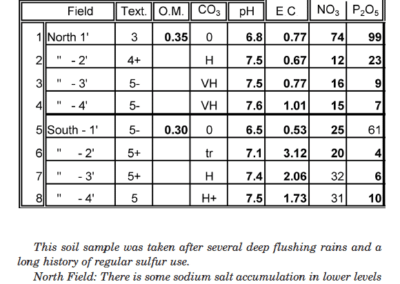By Charles Walters
What is a Soil Test?
A reliable soil test includes three parts:
- Proper sampling, with field and cropping history, and yield goals.
- Chemical tests for nutrients available for crop growth.
- Reliable recommendations for nutrients and amendments needed to attain desired yield goals.
Reading a Soil Test
The following is how laboratory results are reported at Texas Plant & Soil Lab — other labs utilize similar terms.
Texture — Ranges from 1 (sand) to 3 (loam) to 6 (heavy clay)
Cation Exchange Capacity (CEC) — Texture determines the CEC. Textures of 1 = 3-8 CEC. Textures of 6 = 30-50 CEC.
Organic Matter (O.M.) — Humus increases CEC. About 3.5 CEC increase for each percent increase in humus. O.M. improves tilth (soil physical condition), water and nutrient holding capacity. The more the better. Ideal O.M. levels for corresponding texture levels (1-6 respectively) = 2.8, 3.1, 3.6, 4.1, 4.5, 4.8.
Natural Extracting (CO2) — Plants produce natural carbonic acid in the root zone which can be used to obtain nutrient values that are more realistic and calibrates to the plant uptake.
NO3 (N) — This highly soluble nitrate ion moves easily up and down with water and is a constantly changing value. Plant uptake is rapid. Excess can be toxic.
P2O5 (P) — Extracted with CO2, the amount is reported in pounds per acre for the top foot of soil. The amount reported is available to a crop in a normal growing season. Responses can be expected below 40 pounds per acre and high phosphorus requiring crops may respond to additional phosphate of up to a 200 pounds per acre tested.
Potassium (K) — Extractable using CO2. This is the amount available to the crop in a growing season. Readings range from of 80 ppm to 120 ppm for crops with high potash needs. Soil availabilities vary with texture, soil moisture conditions, interference from sodium levels and ratios of Na, Ca and Mg.
pH — The acidity measurement is variable. Most crops prefer a pH between 6.5 and 7.3. Neutral is 7.0, above is alkaline and below is acid. The desirable pH level is a nebulous, dynamic determination that is highly variable.
Electrical Conductivity (EC) Salts — This is a measure of total water-soluble salts expressed as mmhos/cm. EC x 640 = total dissolved solids in ppm.
Salt Cations — Water-soluble cations determined by the atomic absorption spectrophotometer. Calcium is important and should exceed 100 ppm.
CO2 extractable (carbonic acid equivalent) is the same as the plant root process. Sodium is the main extractable harmful element and should be below 180 ppm. The amount of extractable calcium reserve in the soil is also reported and must be known to properly manage excess salts.
Na (CO2)/Ca (H2O) and Na (CO2)/Mg (H2O) — These ratios help evaluate salt problems and are indicators of the soil’s physical condition for water, air and root penetration. The Na:Ca ratio should be less than 6 for good internal drainage. The Na:Mg ratio should be below 20 for regular crops and below 10 for sugar-producing crops such as melons, citrus, sugarcane, etc.
Source: Ask the Plant




